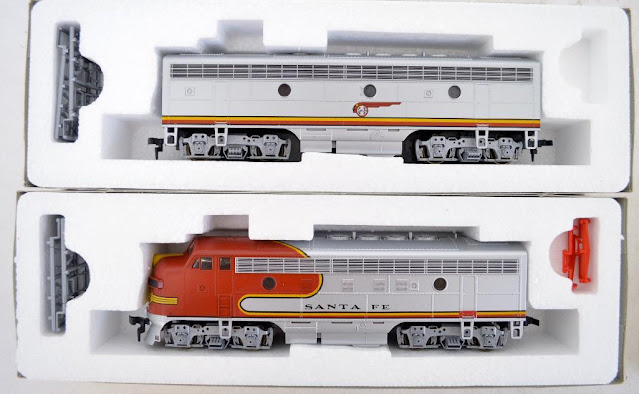Our Victorville locomotives this time are the Santa Fe's 3765-class 4-8-4s, and our layout topics will be the gluing down of more of the cork sheets for the staging yards and then starting to paint them gray.
After their first group of 4-8-4s (the 3751-class), the Santa Fe bought 11 improved 4-8-4s of the 3765 class (#3765-3775) in 1938. These came with 20K "square" oil tenders. During 1950-1952 most of them got new boilers with no external steam dome (all except #3765, 3769, and 3770).
One of them, #3768, was saved and is on display in Wichita, as seen here:
This next shot is from July of 1941 (before my time period), but it shows #3765 leaving Victorville through the Upper Narrows with a westbound heavyweight passenger train. This loco was intended to be streamlined like 4-6-4 #3460, but it would have been too heavy.
Donald Duke shot #3770 with the eastbound Chief at Pine Lodge in the late 1940s:
Here we see #3771 with the 2nd section of the westbound California Limited near Hesperia in Dec. 1946, thanks to A.E. Brown:
Here's another photo of #3771, again near Hesperia after leaving Victorville with the westbound Scout in April, 1946, as shot by William Barham:
Donald Duke photographed #3772 with the westbound Grand Canyon coming through Victorville in the late 1940s:
Here's an often-published Santa Fe photo of #3775 descending the west side of Cajon Pass at the lower end of Cajon siding:
Jack Whitmeyer photographed #3775 with the 2nd section of the eastbound Grand Canyon by the Victorville depot in Sep. 1947:
Then Jack photographed #3775 again as it was leaving town:
It appears that these locos were last seen on Cajon Pass during 1948 and were gone by 1949. #3775 was the only one seen during 1948, but there were others before then.
As for HO models of these locos, I have one of the Key brass models, which is based on #3768 with the new boiler, as seen here, but mine is painted as #3775:
There were also some Hallmark Super Crown models (super expensive) of various locos in the 3765 class, such as this one seen here:
Now let's look at some progress on the lower staging level of my Victorville layout.
On Monday morning two weeks ago George Chambers returned and glued down some remaining cork sheets for the staging yards. He also cut and fit some small, odd-shaped filler pieces. Here he is in the center of the peninsula, spreading some caulk:
Meanwhile, I was threading the blue and yellow bus wires through more of the Velcro straps in the helix room. But some of the straps are coming loose, so I bought a staple gun to attach them more reliably when I find time.
I was the final speaker of the day, and it took me about 65 minutes to go through all my slides, plus a little time for questions:
Meanwhile, I was sanding the joints between the cork sheets and cutting and fitting and gluing a few odd shapes of cork to fill in some gaps.












.jpg)




















